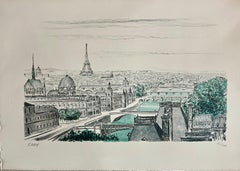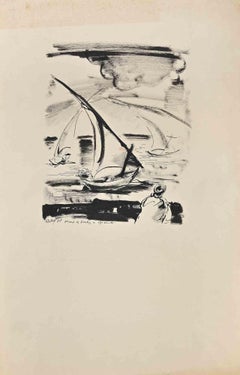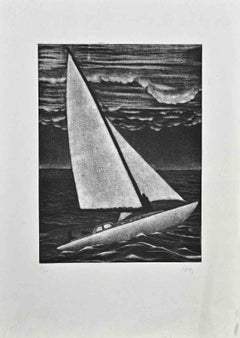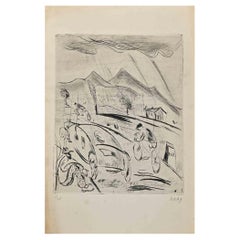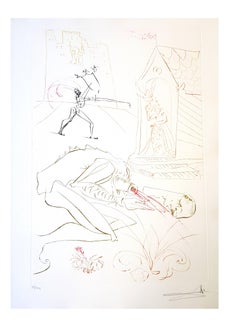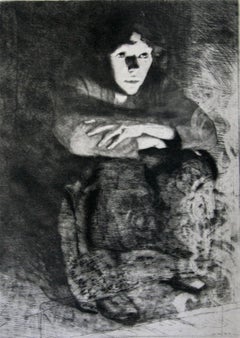Robert Naly Art
Swiss, 1900-1984
Robert Naly was a Swiss artist who worked in France as a landscape painter, decorator and illustrator. In 1927, he moved to Montmartre in Paris to work as a decorator. In 1932, he exhibited in Paris at the Salon d'Automne. Naly died in 1984 in his atelier due to a fire.
to
6
5
Overall Width
to
Overall Height
to
11
3
1
9
1
9
2
9
8
7
4
1
1
1
1
1
1
1
1
1
8
3
3
2
1
11
9,475
2,687
1,375
1,358
6
1
Artist: Robert Naly
Paris and the Seven Bridges
By Robert Naly
Located in Belgrade, MT
This lithograph by Robert Naly is from my private collection. It is a limited edition 192/200, artist signed in the lower left corner.
Guilde de la Gravure
Robert Naly was a Swiss a...
Category
Mid-20th Century French School Robert Naly Art
Materials
Oil, Illustration Board, Lithograph
Boat - Original Ink Drawing by Robert Naly - Mid 20th Century
By Robert Naly
Located in Roma, IT
Boat is an original Contemporary artwork realized in the half of the 20th Century by Robert Naly (1900 - 1983).
Original ink drawing.
Hand-signed.
Good conditions except for con...
Category
Mid-20th Century Modern Robert Naly Art
Materials
Ink
The Human Pot - Original Etching by R. Naly - 1955
By Robert Naly
Located in Roma, IT
Image dimensions: 17 x 17 cm.
The Human Pot is an original contemporary Artwork realized by Robert Naly in 1955.
Original Etching on paper.
Hand-signed in pencil on the lower r...
Category
1950s Surrealist Robert Naly Art
Materials
Etching
Church View - Etching by R. Naly - 1967
By Robert Naly
Located in Roma, IT
Church View is an original print, realized by the French artist Robert Naly in 1967.
The artwork represents a black and white view of a big church.
Hand-signed and dated on the low...
Category
1960s Modern Robert Naly Art
Materials
Etching
Boat - Mezzotint Print by Robert Naly - Mid 20th Century
By Robert Naly
Located in Roma, IT
Boat is a Contemporary artwork realized in the half of the 20th Century by Robert Naly (1900 - 1983).
Mezzotint print.
Hand-signed.
Numbered, edition of 50 prints.
Good conditio...
Category
Mid-20th Century Modern Robert Naly Art
Materials
Drypoint, Etching
The Race - Original Etching by Robert Naly - Mid 20th Century
By Robert Naly
Located in Roma, IT
The Race is an Original Etching and Drypoint realized by Robert Naly (1900-1984).
Good condition on a yellowed paper .
Hand-signed by the artist on the lower right corner.
Category
Mid-20th Century Modern Robert Naly Art
Materials
Drypoint, Etching
Dancers - Original Etching and Drypoint by Robert Naly - Mid 20th Century
By Robert Naly
Located in Roma, IT
Dancers is an Original Etching and Drypoint realized by Robert Naly (1900-1984)
Good condition on a yellowed paper.
Edition of 3/25.
Hand-signed and numbered on the lower margin.
Category
Mid-20th Century Modern Robert Naly Art
Materials
Drypoint, Etching
Flowers - Original Ink Drawing by Robert Naly - Mid 20th Century
By Robert Naly
Located in Roma, IT
Flowers is an original Contemporary artwork realized in the half of the 20th Century by Robert Naly (1900 - 1983).
Original ink drawing.
Hand-signed.
Good conditions except for ...
Category
Mid-20th Century Modern Robert Naly Art
Materials
Ink
Marine Nature - Original Etching on Paper by Robert Naly - 1950s
By Robert Naly
Located in Roma, IT
Marine Nature is an original Contemporary artwork realized in the mid-20th Century by Robert Naly (1900 - 1983).
Original Etching on paper.
Passepartout is included (cm 60 x 40)....
Category
1950s Modern Robert Naly Art
Materials
Etching
Portal - Original Etching by Robert Naly - 1950s
By Robert Naly
Located in Roma, IT
Portal is an original contemprary artwork realized by Robert Naly in the middle of the 20th Century.
Original etching on ivory paper. Image Dimensions: 18 x 14 cm
Hand-signed in p...
Category
1950s Modern Robert Naly Art
Materials
Etching
Figure in the Landscape - Original Etching by Robert Naly - Mid-20th Century
By Robert Naly
Located in Roma, IT
Figure in the Landscape is an original contemprary artwork realized by Robert Naly in the middle of the XX Century.
Original etching on ivory paper. Image Dimensions: 18 x 14 cm
H...
Category
Mid-20th Century Modern Robert Naly Art
Materials
Etching
Related Items
Salvador Dali - Fight Before la Dame - Original Handsigned Etching
By Salvador Dalí
Located in Collonge Bellerive, Geneve, CH
Salvador Dali - Original Handsigned Etching
From La Quête du Graal
Dimensions: 45 x 33 cm
Handsigned
Edition: 38/100
(from the rare deluxe suite aside from the standard edition)
Cat...
Category
1970s Surrealist Robert Naly Art
Materials
Etching
$1,886
H 17.72 in W 13 in D 0.4 in
Dans les Cendres (In the embers)
By Albert Besnard
Located in Storrs, CT
Dans les Cendres (In the embers). 1887. Delteil catalog 67 state iii. State after the plate was cut down and a second figure eliminated (the two earlier states are of the greatest rarity). Etching, drypoint and roulette. 16 3/4 x 12 1/8 (sheet 19 1/2 x 14). Edition 50. Illustrated: Print Collector's Quarterly 9 (1921): 254. A very rich impression with plate tone and drypoint burr, printed on simili-japon. Provenance: Frederick Keppel & Co. This is one of the artist's most striking images. Signed in pencil. Housed in 25 x 20-inch archival mat, suitable for framing.
Paul Albert Besnard, was an impressionist painter. In 1866, the seventeen-year-old son of artist parents began his studies at the École des Beaux-Arts Paris. In 1874, Besnard won the important Prix de Rome, with which the academy distinguished young talent. A portion of the scholarship is a stay of several years in Rome. Besnard married Charlotte Dubray, a sculptress, during this time in Rome. The couple lived in England, where Besnard exhibited at the Royal Academy London, between 1881 and 1884. He became involved with English portrait painting during this period, which had a lasting influence on his work.
In the years that followed, Besnard broke with the academic tradition. In 1886, he presented the portrait of Madame Roger Jourdain...
Category
Late 19th Century Impressionist Robert Naly Art
Materials
Drypoint, Etching
$1,250 Sale Price
37% Off
H 16.75 in W 12.13 in D 0.5 in
Hand painted Artist Proof-Magnolias-Weaver Series-British Awarded Artist #2 of 3
Located in London, GB
This stunning Artist's Proof is an one-off, oil hand-painted and gilded by the artist , signed at front and on the back label too; each proof is 80% hand painted and gold gilded by S...
Category
2010s Abstract Expressionist Robert Naly Art
Materials
Gold Leaf
$509
H 47.25 in W 31.5 in D 0.04 in
Une Escale au Brasil (A Stopover in Brazil)
By Charles Dufresne
Located in New York, NY
Charles Dufresne (1876-1938), Une Escale au Brasil (A Stopover in Brazil), etching and drypoint, c. 1920, signed in pencil lower right margin and inscribed “epreuve de artist” lower ...
Category
1920s Modern Robert Naly Art
Materials
Drypoint, Etching
Hand painted Artist Proof-Lemon Rose Cottage-British Awarded Artist-Large OneOff
Located in London, GB
This stunning large Artist's Proof is an one-off, hand-painted with highlights by the artist , signed at front and on the back label too; this proof is 80% hand painted with original...
Category
2010s Abstract Impressionist Robert Naly Art
Materials
Gesso, Acrylic, Archival Paper, Giclée
$419 Sale Price
20% Off
H 39.38 in W 27.56 in D 0.04 in
20th century drypoint etching figurative animal print horses sketch signed
By Claude Weisbuch
Located in Milwaukee, WI
"Combat Equestre" is an original lithograph by Claude Weisbuch. The artist signed the piece lower right and wrote the edition number (24/100) in the lower left. This piece depicts mu...
Category
1970s Modern Robert Naly Art
Materials
Drypoint, Etching
$4,050
H 27.25 in W 31.25 in
Sea City
By Patrick Hughes
Located in London, GB
Edition of 100 plus 10 AP
Category
2010s Contemporary Robert Naly Art
Materials
Archival Ink, Oil
Blue Pacific Foamy Shorelines, Horizontal Calm Seascape, Minimal Waterscape
By Kind of Cyan
Located in Barcelona, ES
This is an exclusive handprinted limited edition cyanotype.
"Pacific Foamy Shoreline" is a handmade cyanotype print portraying a smooth wave reaching the shore.
Details:
+ Title: Pa...
Category
2010s Minimalist Robert Naly Art
Materials
Watercolor, Lithograph, Paper
Blue Tones Triptych, Serene Gorgeous Clouds, Handmade Cyanotype Watercolor Paper
By Kind of Cyan
Located in Barcelona, ES
This series of cyanotype triptychs showcases the beauty of nature scenes, including stunning beaches and oceans, as well as the intricate textures of w...
Category
2010s American Realist Robert Naly Art
Materials
Emulsion, Lithograph, Monotype, Handmade Paper
Waves of Clouds, Deep Blue Cyanotype Print, Pleasant Cloudy Sky, Large Triptych
By Kind of Cyan
Located in Barcelona, ES
This series of cyanotype triptychs showcases the beauty of nature scenes, including stunning beaches and oceans, as well as the intricate textures of water, forests, and skies. These triptychs are large pieces that feature lush blues, making them an impressive addition to any beautifully designed space.
Each triptych is printed by hand and carefully crafted to capture the unique essence of these natural environments, with a focus on the interplay of light and shadows, and the subtle nuances of tone and texture.
The beach and ocean scenes depict the dynamic beauty of waves crashing against the shore, with the cyanotype process lending a dreamy, ethereal quality to the images. Similarly, the forest and wood scenes...
Category
2010s American Realist Robert Naly Art
Materials
Lithograph, Rag Paper
$704 Sale Price
20% Off
H 40 in W 83 in
Realist Skyscape Triptych in Blue Tones of Serene Cloudy Sky, Handmade Cyanotype
By Kind of Cyan
Located in Barcelona, ES
This series of cyanotype triptychs showcases the beauty of nature scenes, including stunning beaches and oceans, as well as the intricate textures of water, forests, and skies. These...
Category
2010s Realist Robert Naly Art
Materials
Paper, Emulsion, Lithograph
Rare Hand Colored "Cabane Des Hold" - 1st Ed "Description de l’Univers" C. 1683
By Alain Manesson Mallet
Located in Soquel, CA
Rare Engraving "Cabane Des Hold, Terres Artiques, Fig CII," 1st edition "Description de l’Univers, page 281
This rare image depicts the Willem Barentsz expedition of 1597 to Novaya Zemlya, Russia. The engraving, with later hand-coloring, shows the cabin and ship of the Dutch arctic expedition of Barentsz on Novaya Zemlya (Nova Zembla), with the party being attacked (and in some cases apparently eaten) by bears and wolves. Dutch explorer, Willem Barentsz, reached the west coast of Novaya Zemlya in 1594, and in a subsequent expedition of 1596 rounded the northern point and wintered on the northeast coast. Barentsz died during the expedition, and may have been buried on the northern island.
This artwork is a page from a book by 17th century cartographer and engineer, Allain Manesson Mallet (French, 1630-1706), "Description de L'Univers, contenant les differents systêmes du monde, les cartes générals et particulières de la géographie ancienne et modern." Paris: Denys Thierry, 1683.
Presented in an cream colored mat.
Text on verso shown in images.
Mat Size: 11.5"H x 9.07"W
Paper Size: 8.25"H x 5.44"W
Image Size: 5.63"H x 3.75"W
Alain Manesson Mallet (French, 1630-1706) was a 17th century cartographer and military engineer. He started his career as a musketeer in the army of Louis XIV, became a Sergeant-Major in the artillery and an Inspector of Fortifications. He later served under Alfonso VI, King of Portugal...
Category
1680s Realist Robert Naly Art
Materials
Paper, Ink, Gouache
$475
H 11.5 in W 9.07 in D 0.07 in
Previously Available Items
Nocturne in Egypt - Original Etching by R. Naly - 1950s
By Robert Naly
Located in Roma, IT
Image dimensions: 18 x 14 cm.
Nocturne in Egypt is an original contemprary artwork realized by Robert Naly in the middle of the XX Century.
Original etching on ivory paper.
Hand-...
Category
1950s Modern Robert Naly Art
Materials
Etching
H 11.82 in W 9.85 in D 0.04 in
Robert Naly art for sale on 1stDibs.
Find a wide variety of authentic Robert Naly art available for sale on 1stDibs. You can also browse by medium to find art by Robert Naly in etching, drypoint, engraving and more. Much of the original work by this artist or collective was created during the 20th century and is mostly associated with the modern style. Not every interior allows for large Robert Naly art, so small editions measuring 6 inches across are available. Customers who are interested in this artist might also find the work of Bertram Goodman, Earl Horter, and Jacques Monory. Robert Naly art prices can differ depending upon medium, time period and other attributes. On 1stDibs, the price for these items starts at $121 and tops out at $724, while the average work can sell for $334.
